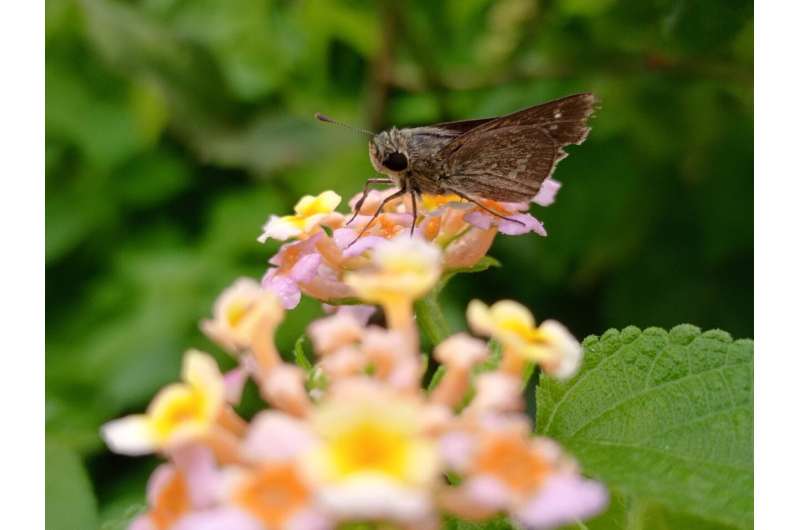This article has been reviewed according to Science X's editorial process and policies. Editors have highlighted the following attributes while ensuring the content's credibility:
fact-checked
trusted source
proofread
Engineered plants produce sex perfume to trick pests and replace pesticides

By using precision gene engineering techniques, researchers at the Earlham Institute in Norwich have been able to turn tobacco plants into solar-powered factories for moth sex pheromones.
Critically, they've shown how the production of these molecules can be efficiently managed so as not to hamper normal plant growth.
Pheromones are complex chemicals produced and released by an organism as a means of communication. They allow members of the same species to send signals, which includes letting others know they're looking for love.
Farmers can hang pheromone dispersers among their crops to mimic the signals of female insects, trapping or distracting the males from finding a mate. Some of these molecules can be produced by chemical processes but chemical synthesis is often expensive and creates toxic byproducts.
Dr. Nicola Patron, who led this new research and heads the Synthetic Biology Group at the Earlham Institute, uses cutting-edge science to get plants to produce these valuable natural products.
Synthetic biology applies engineering principles to the building blocks of life, DNA. By creating genetic modules with the instructions to build new molecules, Dr. Patron and her group can turn a plant such as tobacco into a factory that only needs sunlight and water.
"Synthetic biology can allow us to engineer plants to make a lot more of something they already produced, or we can provide the genetic instructions that allow them to build new biological molecules, such as medicines or these pheromones," said Dr. Patron.
In this latest work, the team worked with scientists at the Plant Molecular and Cell Biology Institute in Valencia to engineer a species of tobacco, Nicotiana benthamiana, to produce moth sex pheromones. The same plant has previously been engineered to produce ebola antibodies and even coronavirus-like particles for use in COVID vaccines.
The Group built new sequences of DNA in the lab to mimic the moth genes and introduced a few molecular switches to precisely regulate their expression, which effectively turns the manufacturing process on and off.
An important component of the new research was the ability to fine tune the production of the pheromones, as coercing plants to continuously build these molecules has its drawbacks.
"As we increase the efficiency, too much energy is diverted away from normal growth and development," explained Dr. Patron.
"The plants are producing a lot of pheromone but they're not able to grow very large, which essentially reduces the capacity of our production line. Our new research provides a way to regulate gene expression with much more subtlety."
In the lab, the team set about testing and refining the control of genes responsible for producing the mix of specific molecules that mimic the sex pheromones of moth species, including navel orangeworm and cotton bollworm moths.
They showed that copper sulfate could be used to finely tune the activity of the genes, allowing them to control both the timing and level of gene expression. This is particularly important as copper sulfate is a cheap and readily-available compound already approved for use in agriculture.
They were even able to carefully control the production of different pheromone components, allowing them to tweak the cocktail to better suit specific moth species.
"We've shown we can control the levels of expression of each gene relative to the others," said Dr. Patron. "This allows us to control the ratio of products that are made."
"Getting that recipe right is particularly important for moth pheromones as they're often a blend of two or three molecules in specific ratios. Our collaborators in Spain are now extracting the plant-made pheromones and testing them in dispensers to see how well they compare to female moths."
The team hope their work will pave the way to routinely using plants to produce a wide range of valuable natural products.
"A major advantage of using plants is that it can be far more expensive to build complex molecules using chemical processes," said Dr. Patron. "Plants produce an array of useful molecules already so we're able to use the latest techniques to adapt and refine the existing machinery."
"In the future, we may see greenhouses full of plant factories—providing a greener, cheaper and more sustainable way to manufacture complex molecules."
The research is published in the journal Plant Biotechnology.
More information: Nicola Patron et al, Tunable control of insect pheromone biosynthesis in Nicotiana benthamiana, Plant Biotechnology (2023). doi.org/10.1111/pbi.14048
Provided by Earlham Institute



















